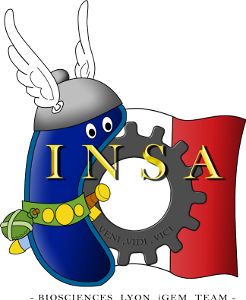Team:Lyon-INSA/modelling
From 2012.igem.org
(Difference between revisions)
Mwolfovski (Talk | contribs) |
Mwolfovski (Talk | contribs) |
||
| Line 107: | Line 107: | ||
<div class="wrapper"> | <div class="wrapper"> | ||
<div class="contenuTexte"> | <div class="contenuTexte"> | ||
| - | + | <u><b>Situation</b></u><br> | |
| + | <br> | ||
| + | After the destruction of the biofilm by “Biofilm Killer” bacteria, we want to have the choice to create either a surfactant to prevent the recolonization of the surface, or a protector biofilm. The switch is done by environmental condition: two inducers can be added to select one behaviour or another.<br> | ||
| + | <br> | ||
| + | <u><b>Biological system to model:</b></u><br> | ||
| + | <br> | ||
| + | For this, we have created the following construction, with a double regulation: | ||
| + | |||
| + | |||
</div> | </div> | ||
</div> | </div> | ||
Revision as of 14:20, 22 September 2012
Modelling
We present here our model.
Click on the title to show/hide the text.
What is modelling ?
Interesting question when you are more a biologist than a mathematician (too many complicated equations!!!) And as most of your team members were biologists/biochemists, we tried to explain the model easily for everyone.
Definitions:
A model is a symbolic representation of an object’s or phenomenon’s aspects in the real world.
“All models are false. Some are useful.” Georges Box
Modeling is the process that allows the development of a model. It’s taking into account:
The tasks to obtain the model depend on the biological situation and the formal system chosen. Nevertheless, it must:
Definitions:
A model is a symbolic representation of an object’s or phenomenon’s aspects in the real world.
“All models are false. Some are useful.” Georges Box
Modeling is the process that allows the development of a model. It’s taking into account:
- The phenomenon to represent
- A specific formal system (equation, diagram..)
- Objectives (what we want to do with the model)
- Data (for variables) and knowledge (relation between variables) available or accessible by experimentation or observation
The tasks to obtain the model depend on the biological situation and the formal system chosen. Nevertheless, it must:
- have a formalization work, which is the model writing
- Manipulate the model in the formal system to make it "usable" and to study its properties
- Objectives (what we want to do with the model)
- Establish relationships with other representations (computer program, graph function)
- Interpret and compare different representations obtained in the formal world with the biological reality (often that reality is seen through experimental data )
Biological System description
Situation
After the destruction of the biofilm by “Biofilm Killer” bacteria, we want to have the choice to create either a surfactant to prevent the recolonization of the surface, or a protector biofilm. The switch is done by environmental condition: two inducers can be added to select one behaviour or another.
Biological system to model:
For this, we have created the following construction, with a double regulation:
After the destruction of the biofilm by “Biofilm Killer” bacteria, we want to have the choice to create either a surfactant to prevent the recolonization of the surface, or a protector biofilm. The switch is done by environmental condition: two inducers can be added to select one behaviour or another.
Biological system to model:
For this, we have created the following construction, with a double regulation:
Biological modelling for dummies !
encore blablabla
Results
BEn on en a pas !
 "
"


